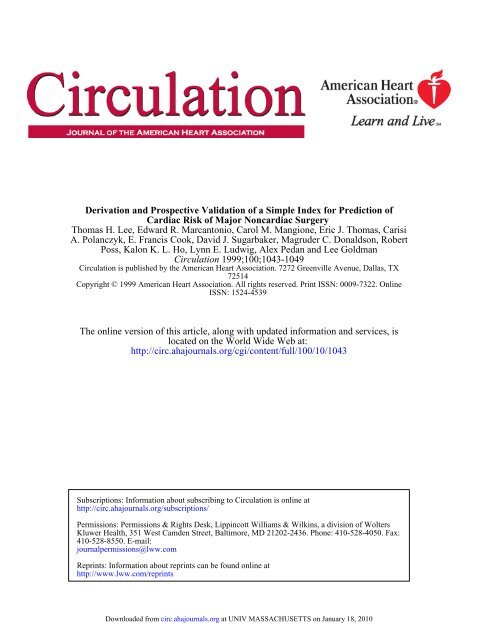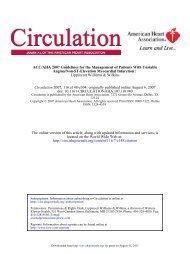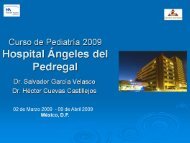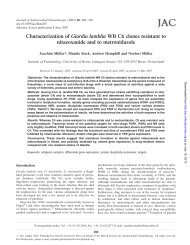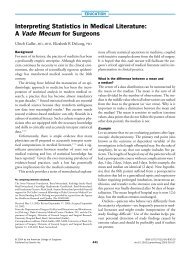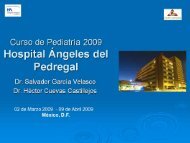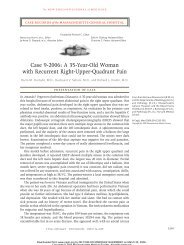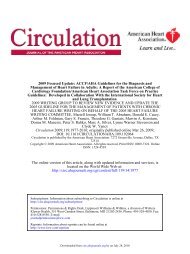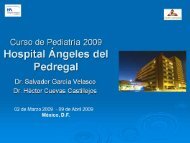1999;100;1043-1049 Circulation Poss, Kalon K. L. Ho, Lynn E ...
1999;100;1043-1049 Circulation Poss, Kalon K. L. Ho, Lynn E ...
1999;100;1043-1049 Circulation Poss, Kalon K. L. Ho, Lynn E ...
- No tags were found...
You also want an ePaper? Increase the reach of your titles
YUMPU automatically turns print PDFs into web optimized ePapers that Google loves.
Derivation and Prospective Validation of a Simple Index for Prediction ofCardiac Risk of Major Noncardiac SurgeryThomas H. Lee, Edward R. Marcantonio, Carol M. Mangione, Eric J. Thomas, CarisiA. Polanczyk, E. Francis Cook, David J. Sugarbaker, Magruder C. Donaldson, Robert<strong>Poss</strong>, <strong>Kalon</strong> K. L. <strong>Ho</strong>, <strong>Lynn</strong> E. Ludwig, Alex Pedan and Lee Goldman<strong>Circulation</strong> <strong>1999</strong>;<strong>100</strong>;<strong>1043</strong>-<strong>1049</strong><strong>Circulation</strong> is published by the American Heart Association. 7272 Greenville Avenue, Dallas, TX72514Copyright © <strong>1999</strong> American Heart Association. All rights reserved. Print ISSN: 0009-7322. OnlineISSN: 1524-4539The online version of this article, along with updated information and services, islocated on the World Wide Web at:http://circ.ahajournals.org/cgi/content/full/<strong>100</strong>/10/<strong>1043</strong>Subscriptions: Information about subscribing to <strong>Circulation</strong> is online athttp://circ.ahajournals.org/subscriptions/Permissions: Permissions & Rights Desk, Lippincott Williams & Wilkins, a division of WoltersKluwer Health, 351 West Camden Street, Baltimore, MD 21202-2436. Phone: 410-528-4050. Fax:410-528-8550. E-mail:journalpermissions@lww.comReprints: Information about reprints can be found online athttp://www.lww.com/reprintsDownloaded from circ.ahajournals.org at UNIV MASSACHUSETTS on January 18, 2010
Derivation and Prospective Validation of a Simple Index forPrediction of Cardiac Risk of Major Noncardiac SurgeryThomas H. Lee, MD, SM; Edward R. Marcantonio, MD, SM; Carol M. Mangione, MD, SM;Eric J. Thomas, MD, SM; Carisi A. Polanczyk, MD; E. Francis Cook, ScD; David J. Sugarbaker, MD;Magruder C. Donaldson, MD; Robert <strong>Poss</strong>, MD; <strong>Kalon</strong> K.L. <strong>Ho</strong>, MD, SM; <strong>Lynn</strong> E. Ludwig, MS, RN;Alex Pedan, PhD; Lee Goldman, MD, MPHBackground—Cardiac complications are important causes of morbidity after noncardiac surgery. The purpose of thisprospective cohort study was to develop and validate an index for risk of cardiac complications.Methods and Results—We studied 4315 patients aged 50 years undergoing elective major noncardiac procedures in atertiary-care teaching hospital. The main outcome measures were major cardiac complications. Major cardiaccomplications occurred in 56 (2%) of 2893 patients assigned to the derivation cohort. Six independent predictors ofcomplications were identified and included in a Revised Cardiac Risk Index: high-risk type of surgery, history ofischemic heart disease, history of congestive heart failure, history of cerebrovascular disease, preoperative treatmentwith insulin, and preoperative serum creatinine 2.0 mg/dL. Rates of major cardiac complication with 0, 1, 2, or 3of these factors were 0.5%, 1.3%, 4%, and 9%, respectively, in the derivation cohort and 0.4%, 0.9%, 7%, and 11%,respectively, among 1422 patients in the validation cohort. Receiver operating characteristic curve analysis in thevalidation cohort indicated that the diagnostic performance of the Revised Cardiac Risk Index was superior to otherpublished risk-prediction indexes.Conclusions—In stable patients undergoing nonurgent major noncardiac surgery, this index can identify patients at higherrisk for complications. This index may be useful for identification of candidates for further risk stratification withnoninvasive technologies or other management strategies, as well as low-risk patients in whom additional evaluation isunlikely to be helpful. (<strong>Circulation</strong>. <strong>1999</strong>;<strong>100</strong>:<strong>1043</strong>-<strong>1049</strong>.)Key Words: risk factors surgery prognosisCardiovascular complications are important causes ofmorbidity with major noncardiac procedures. 1,2 Riskstratification of these patients often relies on noninvasivetests for myocardial ischemia, but analyses suggest that testresults are most useful in patients whose clinical data suggestmoderate risks for complications and that they have limitedimpact in high- or low-risk groups. 3–5Among the tools for clinical risk stratification are theCardiac Risk Index 6 and other decision aids. 7 Recent guidelineshave recommended a modification of the Cardiac RiskIndex, 8,9 but the studies used to develop this and other priordecision aids have relied on small numbers of patients, andthey predated recent advances in surgery and anesthesia.Furthermore, the usefulness of available indexes has beenlimited by the complexity of their formats. We thereforeundertook a prospective investigation to derive and validate asimple index for the prediction of the risk of cardiac complicationsin major elective noncardiac surgery.MethodsPatient PopulationPatients aged 50 years who underwent nonemergent noncardiacprocedures with an expected length of stay 2 days at Brigham andWomen’s <strong>Ho</strong>spital from July 18, 1989, to February 28, 1994, wereeligible for the study. Patients undergoing qualifying procedureswere eligible for the study if they underwent postoperative serialcardiac marker sampling as part of their care or gave their consent tothe full study protocol, which was approved by the <strong>Ho</strong>spitalInstitutional Review Board. The full study protocol included preoperativeinterviews and serial assessments of health status for 1 yearafter surgery. Patients were approached for informed consent for thefull study protocol in the hospital’s Preadmission Test Center or onthe day before surgery if the patient was hospitalized. Comparison ofstudy logs and operating room schedules indicated that 80% ofeligible patients were approached by study personnel.Because some patient subsets underwent preoperative assessmentthrough different systems, the proportion of patients who did notprovide informed consent preoperatively for the serial interviewportion of the study (621 [14.5%] of the study population) washigher among patients who underwent thoracic (31%), abdominalReceived January 19, <strong>1999</strong>; revision received June 1, <strong>1999</strong>; accepted June 19, <strong>1999</strong>.From the Department of Medicine, Brigham and Women’s <strong>Ho</strong>spital and Harvard Medical School, and the Department of Medicine, University ofCalifornia, San Francisco School of Medicine, San Francisco, Calif (L.G.).Reprint requests to Thomas H. Lee, MD, MSc, Partners Community HealthCare, Inc, Prudential Tower Suite 1150, 800 Boylston St, Boston, MA02199.© <strong>1999</strong> American Heart Association, Inc.<strong>Circulation</strong> is available at http://www.circulationaha.org<strong>1043</strong>Downloaded from circ.ahajournals.org at UNIV MASSACHUSETTS on January 18, 2010
1044 <strong>Circulation</strong> September 7, <strong>1999</strong>aortic aneurysm (30%), and other vascular procedures (32%). Patientswho provided informed consent before surgery had a lowermajor cardiac complication rate (see below) than patients who didnot (1.7% versus 4.8%; P0.001).Data CollectionPatients who provided informed consent to the full study protocolunderwent preoperative evaluations by study personnel, includingdetailed medical histories, physical examinations, and laboratorytesting. For patients who could not be approached or refusedparticipation in the interview part of the study, clinical data wereobtained from the structured evaluation provided by the anesthesiologistin the medical record. This data source was also used toobtain American Society of Anesthesiologists (ASA) class for allpatients. Consenting patients agreed to postoperative sampling ofcreatine kinase (CK) and, if total CK levels were elevated, CK-MBimmediately after surgery, at 8 PM on the evening of surgery, and onthe next 2 mornings. For other enrolled patients, samples wereperformed according to the physicians’ orders. For the entire studypopulation, the mean (SD) number of cardiac enzyme samplesobtained was 4.02.2 (median 4). ECGs were performed in therecovery room and on the first, third, and fifth postoperative days ifthe patient remained hospitalized.Total CK was assayed on the ACA discrete clinical analyzer(DuPont). CK-MB was measured until July 30, 1993, with a DuPontACA ion-exchange chromatography and immunoinhibition assay;after that date, a mass assay for CK-MB was performed on theStratus instrument (Baxter Diagnostics).Classification of OutcomesFollow-up data were collected through daily medical record reviewby study personnel. The occurrence of all cardiac complications aftersurgery was classified by a single reviewer (L.G.) who was blindedto preoperative clinical data and who used postoperative clinicalinformation. When the ion-exchange chromatography assay wasused to assay CK-MB, acute myocardial infarction was diagnosed if(1) the peak CK-MB was 5% of an elevated total CK or (2) thepeak CK-MB was 3% of an elevated total CK in the presence ofECG changes consistent with ischemia or infarction. When theCK-MB mass assay was used, acute myocardial infarction wasdiagnosed if peak CK-MB levels exceeded the normal range (5ng/mL) and the ratio of CK-MB to total CK exceeded 0.0278 or, inthe setting of ECG changes, 0.0167. These threshold ratios wereestimated to be comparable to the respective thresholds with theactivity assay for CK-MB on the basis of regression analyses ofsamples for which both assays were used.“Major cardiac complications” included myocardial infarction,pulmonary edema, ventricular fibrillation or primary cardiac arrest,and complete heart block. Diagnosis of pulmonary edema required aformal reading of the chest radiograph by a radiologist consistentwith this complication in a plausible clinical setting.Analysis of DataTwo thirds of the 4315 patients were assigned to the derivationcohort (n2893), which was used to develop the Revised CardiacRisk Index. Patients who underwent vascular surgery were dividedinto those who underwent abdominal aortic aneurysm surgery(n110) versus all other types of vascular surgery (n498). Amongthe other vascular procedures, the most common were femoral-tibialor femoral popliteal artery bypass procedures (46%), carotid endarterectomy(31%), and aorto-bifemoral bypass procedures (9%). Noanalyses were performed for the other 1422 patients (validationcohort) before prospective validation of the Revised Cardiac RiskIndex. The performances of prior decision aids 1,6,7 were compared byuse of receiver operating characteristic curve (ROC) analysis. 10To develop the revised risk index, clinical correlates of majorcardiac complications were identified with a 2 test for categoricalvariables and a t test or Wilcoxon test for continuous variables.Different combinations of clinical variables were tested to identifythe definition of ischemic heart disease most strongly correlated withcardiac complications. Variables with a univariate correlation with aP value 0.10 were considered in stepwise logistic regressionanalyses that identified the factors included in the risk index, with acutoff P value of 0.05. We compared 2 versions of the new index: 1in which weights were derived from the logistic regression analysisand 1 in which all variables were assigned an equal value. BecauseROC analyses did not show an advantage for the index with variableweights, the index with equal weights for all variables was adopted.The Revised Cardiac Risk Index was then tested by differentapproaches, including comparison of major cardiac complicationrates within risk classes in the derivation and validation cohorts,analysis of whether the factors were independent predictors of risk inthe validation cohort, and comparison of the areas under the ROC forrisk-prediction indexes.ResultsThe patients in the derivation and validation cohorts weresimilar (Table 1), with slightly more patients in the validationcohort undergoing procedures identified as high risk in theOriginal Cardiac Risk Index (ie, intraperitoneal, intrathoracic,or suprainguinal vascular). Rates of major cardiac complicationswere 2% and 2.5%, respectively (Table 2).When 3 prior decision aids were applied in the derivationcohort, all 3 were able to stratify patients into subsets withincreasing rates of adverse outcomes (Table 3), but fewpatients fell into high-risk groups. Only 4% of patients wereclassified above class I in the Modified Cardiac Risk Index,and only 3% of patients were assigned the highest ASA class.Correlates of Complications in theDerivation CohortThe combination of variables that defined preoperative ischemicheart disease with the highest correlation with majorcardiac complications included any of the following: historyof myocardial infarction, history of a positive exercise test,current complaint of chest pain considered to be secondary tomyocardial ischemia, use of nitrate therapy, or ECG withpathological Q waves. In the derivation cohort, major cardiaccomplications occurred in 1 (2%) of 51 patients with a historyof prior angioplasty versus 55 (2%) of 2842 patients withoutprior angioplasty and in 6 (3%) of 217 patients with priorCABG surgery versus 50 (2%) of 2676 patients without priorbypass surgery (PNS). Therefore, patients with prior coronaryrevascularization procedures were categorized as havingischemic heart disease only if they had any of the othercriteria for ischemic heart disease listed above. This definitionexcluded 1 patient with prior coronary angioplasty and26 patients with prior CABG surgery, none of whom hadmajor perioperative cardiac complications. Preoperative ECGST-T–wave changes (ST segment elevation or depression orT wave inversion) also were not associated with worseoutcomes.Congestive heart failure was defined by the presence ofany of the following: history of congestive heart failure,pulmonary edema, or paroxysmal nocturnal dyspnea; physicalexamination showing bilateral rales or S3 gallop; or chestradiograph showing pulmonary vascular redistribution. All ofthese variables were correlated with major cardiac complications.Cerebrovascular disease was defined as a history oftransient ischemic attack or stroke.Downloaded from circ.ahajournals.org at UNIV MASSACHUSETTS on January 18, 2010
Lee et al Cardiac Risk Index for Major Noncardiac Surgery 1045TABLE 1.Clinical Characteristics of Patients in Derivation and Validation CohortsDerivation Cohort(n2893)Validation Cohort(n1422)Relative Risks for MajorCardiac Complicationsand 95% CIs inDerivation CohortMale sex*, n (%) 1374 (47) 722 (51) 2.6 (1.5, 4.6)Age 70 y, n (%) 998 (35) 475 (33) 1.9 (1.1, 3.2)MeanSD age, y 66.410.1 66.39.0Type of procedure, n (%)Thoracic 346 (12) 184 (13) 1.1 (0.5, 2.3)Orthopedic 1026 (35) 463 (33) 0.4 (0.2, 0.8)Abdominal aortic aneurysm 110 (4) 64 (5) 3.6 (1.7, 7.8)Other vascular 498 (17) 226 (16) 3.9 (2.3, 6.5)Other abdominal 324 (11) 184 (13) 0.8 (0.3, 1.9)Other 578 (20) 292 (21) 0.1 (0.04, 0.6)High-risk procedures (intraperitoneal, intrathoracic, or894 (31) 490 (34) 2.1 (1.2, 3.5)suprainguinal vascular procedures)*History of myocardial infarction, n (%)Ever 422 (15) 216 (15) 3.5 (2.1, 6.0)In last 180 days 19 (1) 12 (1) 2.8 (0.4, 18.9)Current history of ischemic chest pain, n (%) 376 (13) 185 (13) 2.9 (1.7, 5.1)History of noninvasive test indicating myocardial ischemia, n (%) 200 (7) <strong>100</strong> (7) 2.9 (1.5, 5.7)Current use of nitroglycerin, n (%) 78 (3) 55 (4) 4.1 (2.1, 8.2)History of congestive heart failure, n (%) 183 (6) 99 (7) 2.1 (1.0, 4.6)History of pulmonary edema, n (%) 73 (3) 40 (3) 2.2 (0.7, 6.8)History or physical examination showing significant valvular104 (4) 52 (4) 3.2 (1.4, 7.3)heart disease, n (%)History of cerebrovascular disease, n (%)Transient ischemic attack 175 (6) 89 (6) 4.7 (2.6, 8.6)Prior cerebrovascular accident 155 (5) 78 (5) 2.9 (1.4, 6.1)Use of insulin for treatment of diabetes mellitus, n (%) 112 (4) 59 (4) 3.5 (1.6, 7.7)Preoperative evaluation, n (%)Rales at both bases or higher 195 (7) 105 (7) 3.0 (1.5, 5.9)S3 gallop 38 (1) 18 (1) 0Preoperative laboratory tests, n (%)Abnormal rhythm 188 (6.5) 112 (8) 0.8 (0.3, 2.6)Pathological Q waves on ECG 493 (17) 231 (16) 2.4 (1.3, 4.2)Cardiomegaly on preoperative chest x-ray 129 (4) 74 (5) 3.1 (1.4, 6.6)Serum creatinine 2.0 mg/dL 103 (4) 55 (4) 5.2 (2.6, 10.3)Poor general medical status 381 (13) 179 (13) 1.8 (1.0, 3.4)Ischemic heart disease†, n (%) 951 (33) 478 (34) 3.2 (1.9, 5.4)Congestive heart failure†, n (%) 434 (15) 255 (18) 3.4 (2.0, 5.7)*P0.05 in comparison of derivation and validation cohorts.†Definition of summary variables: “Ischemic heart disease” indicates patient has history of myocardial infarction, positive exercise test, currentcomplaint of ischemic chest pain or use of nitrate therapy, or ECG with Q waves. Patients with prior CABG surgery or PTCA were included in thisdefinition only if they had current complaints of chest pain that were presumed to be due to ischemia. “Congestive heart failure” indicates historyof congestive heart failure, pulmonary edema, or paroxysmal nocturnal dyspnea, physical examination showing bilateral rales or S3 gallop, or chestradiograph showing pulmonary vascular redistribution.Some factors included in the Original Cardiac Risk Indexwere present in few patients and were not associated withmajor cardiac complications. Only 19 patients (1%) had ahistory of myocardial infarction in the last 180 days (Table 1),and only 5 (0.2%) had critical aortic stenosis. No patient wasconsidered to have unstable angina, class IV congestive heartfailure, or active transient ischemia attacks.Patients who were using -adrenergic blocking agents atthe time of admission had a similar rate of cardiac complications(13/533 patients; 2.4%) as patients who were notDownloaded from circ.ahajournals.org at UNIV MASSACHUSETTS on January 18, 2010
1046 <strong>Circulation</strong> September 7, <strong>1999</strong>TABLE 2.Major Cardiac Complications in Derivation and Validation CohortsDerivation Set(n2893)Validation Set(n1422)PAny major cardiac complication, n (%) 56 (2) 36 (2.5) NSVentricular fibrillation/cardiac arrest 9 (0.3) 7 (0.5) NSComplete heart block 2 (0.1) 2 (0.1) NSAcute myocardial infarction 28 (1.0) 18 (1.3) NSPulmonary edema 24 (0.8) 18 (1.3) NSCardiac death during admission, n (%) 8 (0.3) 4 (0.3) NSTotal (cardiac and noncardiac) mortalityduring admission, n (%)22 (0.8) 21 (1.5) 0.05using these medications (43/2360; 1.8%). In stratified analyses,-blockers were not associated with major cardiaccomplication rates in patients with or without ischemic heartdisease. There was a trend toward higher complication ratesin patients with worse functional capacity as measured bySpecific Activity Scale class (1.03%, 1.66%, 2.07%, and2.98%, respectively; 2 test P0.05).In logistic regression analyses, 6 independent (P0.05)correlates of major cardiac complications were identified inthe derivation cohort. These variables (and the rate of majorcardiac complications for patients with these characteristics)included high-risk type of surgery (27/894; 3%), ischemicheart disease (34/951; 4%), congestive heart failure (23/434;5%), history of cerebrovascular disease (17/291; 6%), insulinTABLE 3. Major Cardiac Complication Rates and 95% CIs in Derivation and ValidationCohorts Stratified by Risk Classification SystemDerivation Cohort (n2893)Validation Cohort (n1422)Events/Pop Rate (95% CI) Events/Pop Rate (95% CI)Original Cardiac Risk IndexClass I 31/2200 1.4 (1.0, 2.0) 13/1039 1.3 (0.7, 2.1)Class II 20/561 3.6 (2.2, 5.5) 15/297 5.1 (2.9, 8.2)Class III 5/127 3.9 (1.3, 8.9) 8/84 9.5 (4.2, 17.9)Class IV 0/5 0 0/2 0ROC area (SE) 0.606 (0.034) 0.701 (0.043)Modified Cardiac Risk IndexClass I 49/2786 1.8 (1.3, 2.3) 29/1371 2.1 (1.4, 3.0)Class II 6/95 6.3 (2.4, 13.2) 4/44 9.1 (2.5, 12.8)Class III 1/12 8.3 (0.2, 38.5) 3/7 42.9 (9.9, 82)ROC area (SE) 0.545 (0.022) 0.582 (0.034)ASA classClass I 0/140 0 0/65 0Class II 14/1558 0.9 (0.5, 1.5) 7/729 1.0 (0.4, 2.0)Class III 35/1078 3.3 (2.3, 4.5) 24/561 4.3 (2.8, 6.3)Class IV 7/81 8.6 (3.5, 17) 4/43 9.3 (2.6, 22.1)ROC area (SE) 0.697 (0.031) 0.706 (0.036)Revised Cardiac Risk IndexClass I 5/1071 0.5 (0.2, 1.1) 2/488 0.4 (0.05, 1.5)Class II 14/1106 1.3 (0.7, 2.1) 5/567 0.9 (0.3, 2.1)Class III 18/506 3.6 (2.1, 5.6) 17/258 6.6 (3.9, 10.3)Class IV 19/210 9.1 (5.5, 13.8) 12/109 11.0 (5.8, 18.4)ROC area (SE) 0.759 (0.032)* 0.806 (0.034)†*Within the derivation cohort, P0.05 for comparison of performance of Original vs Modified Cardiac Risk Index,Modified Risk Index vs ASA class, and Original Cardiac Risk Index vs ASA class. Also within the derivation cohort,P0.001 for comparison of Revised Cardiac Risk Index vs both Original and Modified Cardiac Risk Index, andP0.055 for comparison of Revised Cardiac Risk Index vs ASA class. Data on ASA class were missing for 36 patients.†Within the validation cohort, P0.021 for comparison of Revised Cardiac Risk Index vs Original Cardiac RiskIndex, P0.0001 for comparison of Revised Cardiac Risk Index vs Modified Cardiac Risk Index, and P0.018 forcomparison of Revised Cardiac Risk Index vs ASA class. Data on ASA class were missing for 24 patients.Downloaded from circ.ahajournals.org at UNIV MASSACHUSETTS on January 18, 2010
Lee et al Cardiac Risk Index for Major Noncardiac Surgery 1047Bars represent rate of major cardiac complicationsin entire patient population (both derivationand validation cohorts combined) forpatients in Revised Cardiac Risk Index classesaccording to type of procedure performed. AAAindicates abdominal aortic aneurysm. Note thatby definition, patients undergoing AAA, thoracic,and abdominal procedures wereexcluded from class I. In all subsets exceptpatients undergoing AAA, there was a statisticallysignificant trend toward greater risk withhigher risk class.therapy for diabetes (7/112; 6%), and preoperative serumcreatinine 2.0 mg/dL (9/103; 9%).Derivation of the Revised Cardiac Risk IndexA logistic regression model that included the 6 independentcorrelates of major cardiac complications indicated that theadjusted OR for these factors ranged from 1.9 to 3.0. Twoindexes were derived from this model. In the variable-weightindex, point values were assigned in proportion to the logisticregression model weights for each variable. In the equalweightmodel, 1 point was assigned to each variable. ROCanalysis showed no significant difference between the diagnosticperformances of the models (0.7650.032 versus0.7590.032, respectively; P0.28). Therefore, the RevisedCardiac Risk Index was constructed with each risk factorassigned 1 point.Patients with 0, 1, 2, or more factors were assigned to classesI, II, III, or IV, respectively; rates of major cardiac complicationsranged from 0.5% to 9% (Table 3). Statistically significant(P0.05) differences were found in rates of major cardiaccomplications between all classes. ROC analysis indicated thatthe diagnostic performance of the Revised Cardiac Risk Indexwas superior to all 3 of the prior decision aids.Validation of the Prediction RuleDiagnostic performance of the Revised Cardiac Risk Indexwas similar in the derivation and validation cohorts, asreflected in ROC analyses (Table 3). Within any specificclass of the Revised Cardiac Risk Index, the complicationrates were not statistically different between the derivationand validation cohorts. Within the validation cohort, therelative risk for patients in class II compared with patients inclass I (2.2 [95% CI 0.4, 11.0]) was not significantly differentfrom the corresponding relative risk in the derivation cohort(2.7 [95% CI 1.0, 7.5]).In the validation cohort, the outcome rate was significantlyhigher in class III than class II (6.6% versus 0.9%; P0.001).The relative risk of class III versus class II in the validationcohort (7.5 [95% CI 2.8, 20.0]) was not significantly differentfrom the corresponding relative risk in the derivation cohort(2.8 [95% CI 1.4, 5.6]) (P0.11).The difference between class IV and class III in outcomerates in the validation cohort did not reach statistical significance(11.0% versus 6.6%; P0.15). The relative risk ofclass IV versus class III in the validation cohort (1.7 [95% CI0.8, 3.4]) was not significantly different from the correspondingrelative risk in the derivation cohort (2.5 [95% CI 1.4,4.7]) (P0.38).Four of the factors in the Revised Cardiac Risk Index wereindependent correlates of major cardiac complications in thevalidation cohort: high-risk type of surgery, ischemic heartdisease, congestive heart failure, and history of cerebrovasculardisease. There were trends or significant univariateassociations with major cardiac complications for insulintherapy for diabetes (3/59 patients, 5%; relative risk 2.4; 95%TABLE 4. Rates of Major Cardiac Complications and Multivariate ORs* Among Patients With IndividualRisk Factors in Derivation and Validation SetsDerivation Set (n2893)Validation Set (n1422)CrudeDataAdjusted OR(95% CI)CrudeDataAdjusted OR(95% CI)Revised Cardiac Risk Index1. High-risk type of surgery 27/894 (3%) 2.8 (1.6, 4.9) 18/490 (4%) 2.6 (1.3, 5.3)2. Ischemic heart disease 34/951 (4%) 2.4 (1.3, 4.2) 26/478 (5%) 3.8 (1.7, 8.2)3. History of congestive heart failure 23/434 (5%) 1.9 (1.1, 3.5) 19/255 (7%) 4.3 (2.1, 8.8)4. History of cerebrovascular disease 17/291 (6%) 3.2 (1.8, 6.0) 10/140 (7%) 3.0 (1.3, 6.8)5. Insulin therapy for diabetes 7/112 (6%) 3.0 (1.3, 7.1) 3/59 (5%) 1.0 (0.3, 3.8)6. Preoperative serum creatinine 2.0 mg/dL 9/103 (9%) 3.0 (1.4, 6.8) 3/55 (5%) 0.9 (0.2, 3.3)*Based on logistic regression models including these 6 variables.Downloaded from circ.ahajournals.org at UNIV MASSACHUSETTS on January 18, 2010
1048 <strong>Circulation</strong> September 7, <strong>1999</strong>CI 1.2, 4.8) and for preoperative serum creatinine 2.0mg/dL (3/55 patients, 5%; relative risk 2.3; 95% CI 0.7, 7.1).These variables were not independent correlates of cardiaccomplications in the multivariate analysis within the validationcohort (adjusted OR 1.0 and 0.9, respectively), but theORs for major cardiac complications for these 2 variableswere not significantly different in derivation and validationcohorts.Within the validation cohort, comparisons of areas underthe ROC indicated better diagnostic performance of theRevised Cardiac Risk Index compared with the prior decisionaids (all P0.01). The Revised Cardiac Risk Index was alsocompared with a prior index for patients undergoing vascularsurgery. 2 ROC analysis indicated superior diagnostic performanceof the Revised Cardiac Risk Index in the entire patientpopulation (0.7770.023 versus 0.6450.032; P0.0001),in the validation cohort (0.8060.034 versus 0.6080.056;P0.001), and in the subset of patients undergoing vascularsurgery (0.7740.032 versus 0.6830.046; P0.05). Neitherof these indexes performed well among patients undergoingabdominal aortic aneurysm surgery (0.5430.092 forRevised Cardiac Risk Index versus 0.4840.074 for thevascular surgery index; P0.30).Finally, a version of the Revised Cardiac Risk Index with onlythe 4 variables with independent associations with complicationsin the validation cohort (excluding diabetes and renal function)yielded slightly superior diagnostic performance compared withthe 6-variable model. Complication rates in patients with none,1, 2, or more of these variables were 0.4% (2/493), 1.0% (6/579),7% (19/270), and 11% (9/80).Performance by Procedure TypePatients from both the derivation and validation cohorts werepooled for an analysis of the performance of the RevisedCardiac Risk Index within types of procedures (Figure).Except for patients undergoing abdominal aortic aneurysmsurgery, there were significant (P0.05) trends towardgreater rates of cardiac complications within higher-riskclasses within all procedure types.DiscussionIn this report of the risk of major cardiac complications withmajor nonemergent noncardiac surgery, 6 factors with approximatelyequal prognostic importance were identified. Thepresence of 2 of these factors identified patients withmoderate (7%) and high (11%) complication rates in prospectiveevaluation among 1422 patients in the validation cohort.These findings are consistent with prior research andguidelines 5,8 that have emphasized the value of clinical datain perioperative risk stratification. Other investigations havealso found increased risk among patients with cardiovasculardisease or diabetes mellitus 1,2,8,11 or with certain classes ofprocedures. 6 <strong>Ho</strong>wever, several previously identified risk factors,including advanced age, critical aortic valvular stenosis,and abnormal cardiac rhythms, did not correlate with complicationsin the present study. This finding may reflectpatient selection and increased attention to these issues.Therefore, the absence of these factors from the RevisedCardiac Risk Index should not be taken as evidence that theyare not worrisome prognostic factors; indeed, they might beimportant predictors in patients undergoing emergentoperations.There was no relationship between risk class and majorcardiac complications among the patients who underwentabdominal aortic aneurysm surgery. Because there were only110 patients who underwent this procedure in the derivationcohort, statistical power was limited in these analyses.The form and content of the Revised Cardiac Risk Indexreflect the goal of this investigation: to derive a simple indexthat might influence and be readily incorporated into routinepractice (eg, on forms for preoperative evaluations). Wetherefore emphasized in the analyses dichotomous variablesthat were either present or absent and used a scoring systemthat assigned 1 point to each variable. A more complex indexmight have achieved greater accuracy but at the expense ofease of use.<strong>Ho</strong>w the Revised Cardiac Risk Index should be used byclinicians remains to be defined. One approach is to confineroutine use of noninvasive testing to patients with moderaterisk for complications (eg, classes III or IV). 3 An alternativestrategy has been suggested by Bodenheimer, 12 who arguesthat improved outcomes are more likely to result fromcontrolling postoperative oxygen demand than additional riskstratification. This approach would support use of this indexto identify patients who should be treated with strategies toreduce oxygen consumption rather than undergo additionalnoninvasive testing.The findings from the present report should be interpretedin the context of the study design. The data were collectedfrom patients undergoing nonemergent operations at a singleteaching hospital. The Revised Cardiac Risk Index is ofuncertain generalizability in lower-risk populations, such aspatients who undergo more minor procedures, or in high-riskpopulations, such as those who undergo emergency operations.<strong>Ho</strong>wever, patients undergoing major nonemergent proceduresconstitute the population in which physicians mostoften have to consider additional testing or other strategiesbefore the patient proceeds to surgery. Other clinical factorsnot included in this index may be important for predictinglong-term prognosis and warrant attention by clinicians.Finally, although this cohort is perhaps the largest to bestudied prospectively for predictors of cardiac complicationsassociated with noncardiac surgery, the statistical power toidentify predictors of complications among specific patientsubsets was limited.Nevertheless, these findings are consistent with priorresearch, and the Revised Cardiac Risk Index appears simpleenough for easy application in patient care. Previouslypublished data on a subset of this cohort demonstrate thatpatients with at least 3 of the factors in the Revised CardiacRisk Index (history of ischemic heart disease, history ofcongestive heart failure, and diabetes mellitus) have anincreased risk for cardiovascular complications during thenext 6 months, even if they do not have major perioperativecardiac complications. 13 Hence, patients with increased perioperativerisk probably warrant closer clinical attention wellbeyond their hospital admission.Downloaded from circ.ahajournals.org at UNIV MASSACHUSETTS on January 18, 2010
Lee et al Cardiac Risk Index for Major Noncardiac Surgery <strong>1049</strong>AcknowledgmentThis study was supported by a grant from the Agency for HealthCare Policy and Research, Rockville, Md (RO1-HS06573).References1. L’Italien GJ, Paul SD, Hendel RC, Leppo JA, Cohen MC, Fleisher LA,Brown KA, Zarich SW, Cambria RP, Cutler BS, Eagle KA. Developmentand validation of a Bayesian model for perioperative cardiac riskassessment in a cohort of 1,081 vascular surgery patients. J Am CollCardiol. 1996;27:779–786.2. Mangano DT, Layug UL, Wallace A, Tateo I. Effect of atenolol onmortality and cardiovascular morbidity after noncardiac surgery. N EnglJ Med. 1996;335:1713–1720.3. Mangano DT, Goldman L. Preoperative assessment of patients withknown or suspected coronary disease. N Engl J Med. 1995;333:1750–1756.4. Guidelines for perioperative cardiovascular evaluation for noncardiacsurgery: report of the American College of Cardiology/American HeartAssociation Task Force on Practice Guidelines. <strong>Circulation</strong>. 1996;93:1278–1317.5. Eagle KA, Froehlich JB. Reducing cardiovascular risk in patientsundergoing noncardiac surgery. N Engl J Med. 1996;335:1761–1763.6. Goldman L, Caldera DL, Nussbaum SR, Southwick FS, Krogstad D,Murray B, Burke DS, O’Malley TA, Goroll AH, Caplan CH, Nolan J,Carabello B, Slater EE. Multifactorial index of cardiac risk in noncardiacsurgical procedures. N Engl J Med. 1977;297:845–850.7. Detsky AS, Abrams HB, McLaughlin JR, Drucker DJ, Sasson Z, JohnstonN, Scott JG, Forbath N, Hilliard JR. Predicting cardiac complications inpatients undergoing noncardiac surgery. J Gen Intern Med. 1986;1:211–219.8. American College of Physicians. Guidelines for assessing and managingthe perioperative risk from coronary artery disease associated with majornoncardiac surgery. Ann Intern Med. 1997;127:309–312.9. Palda VA, Detsky AS. Perioperative assessment and management of riskfrom coronary artery disease. Ann Intern Med. 1997;127:313–328.10. Hanley JA, McNeil BJ. The meaning and use of the area under a receiveroperating characteristic (ROC) curve. Radiology. 1982;143:29–36.11. Bartels C, Bechtel JFM, <strong>Ho</strong>ssman V, <strong>Ho</strong>rsch S. Cardiac risk stratificationfor high-risk vascular surgery. <strong>Circulation</strong>. 1997;95:2473–2475.12. Bodenheimer M. Noncardiac surgery in the cardiac patient: what is thequestion? Ann Intern Med. 1996;124:763–766.13. Lopez-Jimenez, F, Goldman L, Sacks DB, Thomas EJ, Johnson PA, CookEF, Lee TH. Prognostic value of cardiac troponin T after noncardiacsurgery: 6-month follow-up data. J Am Coll Cardiol. 1997;29:1241–1245.Downloaded from circ.ahajournals.org at UNIV MASSACHUSETTS on January 18, 2010


